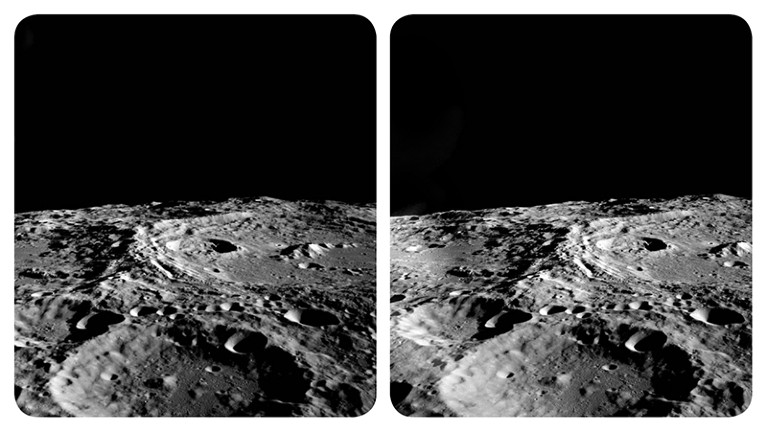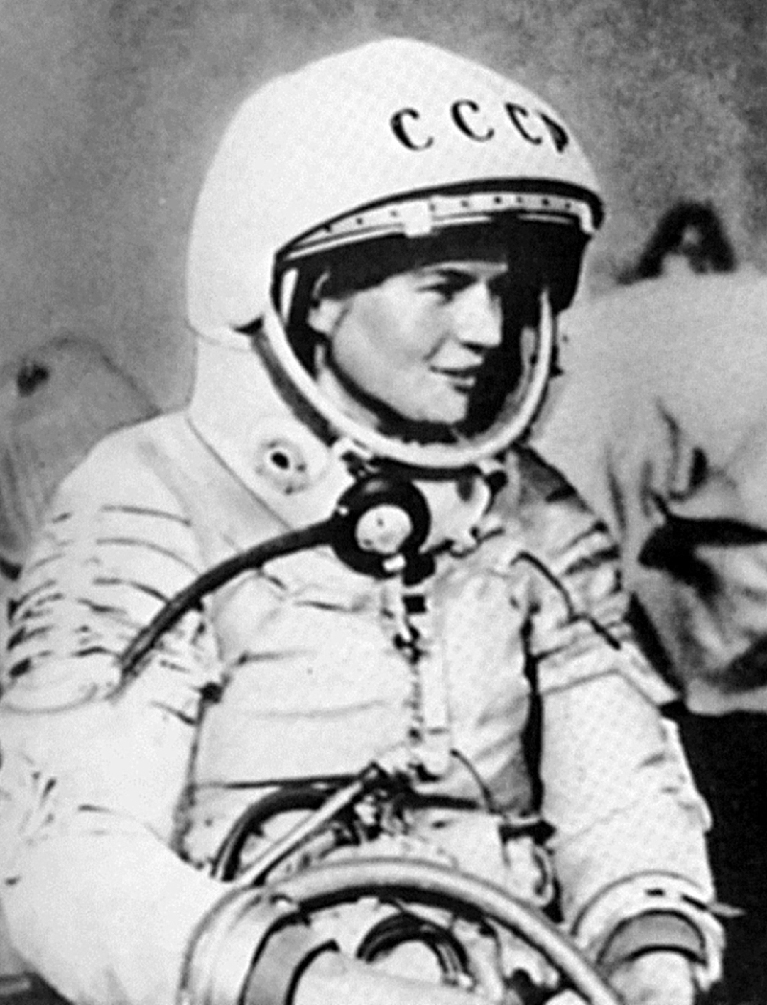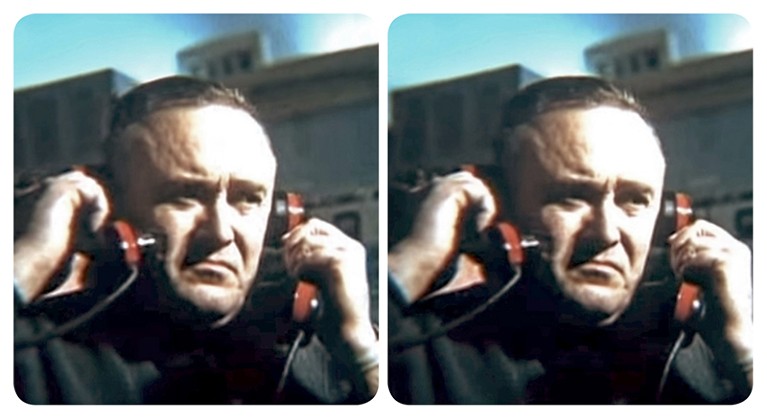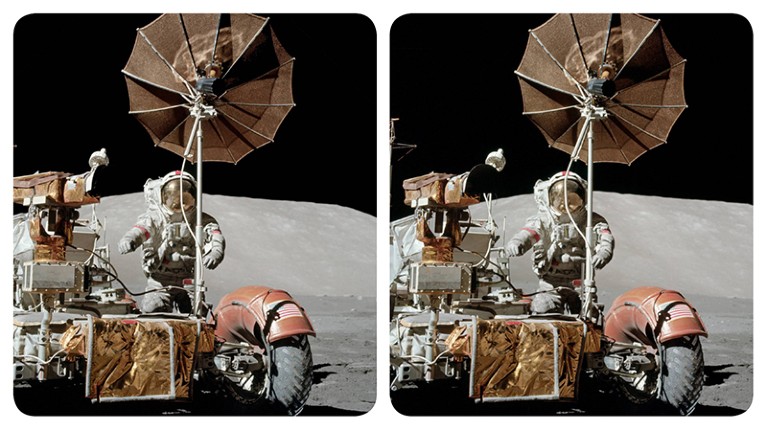
A stereoscopic image created from a handheld view of the Moon’s surface taken by the Apollo 10 astronauts, showing the far-side craters Stratton, Keeler and Heaviside.Credit: Mission Moon 3-D
Mission Moon 3-D: Reliving the Great Space Race David J. Eicher and Brian May London Stereoscopic Company (2018)
In 2019, it will be 50 years since the first Moon landing. Almost more remarkable is that no human has touched that surface since Gene Cernan’s lunar stroll during the last of NASA’s Apollo missions in 1972. To celebrate the scale of that programme, writer and editor David Eicher, together with Brian May — astrophysicist, Queen guitarist and stereoscopic photographer — take us back to the beginning in the spectacular Mission Moon 3-D.
On 25 May 1961, President John F. Kennedy declared that the United States would land a man on the Moon and bring him safely back before the decade was out. That ambitious timetable surprised the president’s own science advisers, as well as the US Congress and the rest of the world. Kennedy was spurred by the phenomenal successes of Soviet space exploration. Sputnik 1, launched in 1957, was the first artificial satellite to orbit Earth; and a month before Kennedy issued his challenge, Yuri Gagarin had become the first human in space.
The story of how NASA overtook the Soyuz programme during the cold war has been told many times — in interviews and books and on film. So what do Eicher and May bring to the table?
Primarily, Eicher compares the Soviet and US space programmes — their successes and failures. This political, cultural and technical context is enriched with information that has come from the cosmonauts themselves in recent years. For example, details of the accidents and deaths that hindered the Soviet lunar programme, from the cosmonauts’ point of view, enable Eicher to tell a more complete story. He strikes a fine balance between detail and readability.
Soviet cosmonaut Valentina Tereshkova. The former factory worker was the first woman in space, flying in Vostok 6 in 1963.Credit: Mission Moon 3-D
But the book is so much more. Its 150 stereo photographs, which can be seen in 3D through a stereo viewer, make it an immersive experience. Since childhood, May has collected stereoscopic devices — a Victorian technology in which two photographs of the same subject (taken a small horizontal distance apart) are displayed side by side. Looking at these through a viewing device, at a certain distance and with eyes ‘relaxed’, the brain creates the perception of depth, and previously unresolved details jump into focus. The pairs of images that Eicher and May include show everything from cosmonaut Alexei Leonov, the first spacewalker, in 1965, to the Apollo 12 lunar module Intrepid flying insect-like above the Moon’s surface in 1969. A hand-held LITE OWL viewer developed by May is included with the book with instructions. For those struggling to see in 3D, try starting with high-contrast images such as the one of Comet 67P/Churyumov-Gerasimenko.
Stereo photography was not an aim of the Apollo missions. But many sequential photographs were taken — for instance by Stuart Roosa in Apollo 14 while circling the Moon — which enabled May to assemble several pairs. May and his team also trawled the NASA archives to find serendipitous pairs of photographs or film stills with just the right baseline separation. To illustrate the Soviet effort, for which no sequential images existed, they had to convert ‘mono’ photographs into stereo pairs.

Sergei Korolev, father of the Soviet space programme, a stereoscopic view created by pairing two screenshots from a 1950s public information film.Credit: Mission Moon 3-D
As these vivid images remind us, the pace of progress would have been much slower without the fierce competitiveness of the space race. However, the cold-war wall between the two countries made avoidable, sometimes tragic, mistakes inevitable. One chilling example is the Apollo 1 accident in 1967. During a routine countdown rehearsal, a fire erupted in the craft’s main capsule, which contained pure oxygen; astronauts Roger Chaffee, Gus Grissom and Ed White died almost instantly. (Only later was a quick-release hatch added to the design.) Six years before, unbeknown to NASA, trainee cosmonaut Valentin Bondarenko had suffered a similar fate during a test in Moscow. The two superpowers’ first cooperative spaceflight would have to wait until 1975.
Mission Moon 3-D devotes significant space to the ultimate sacrifice made by humans (and animals) in the name of space exploration, underlining the risks of propelling earthlings into an alien environment. Now, NASA, the Russian, Japanese and Chinese space agencies, and the private companies SpaceX and Blue Origin, plan to send humans back to the Moon. Before that happens, any benefits must be weighed carefully against the risks, and the expense. Reaching Mars will demand that several nations work together, with involvement from the public and private sectors. Robotic and telescopic missions cost much less and can reach more-distant planets and moons. But there is no substitute for human experience; and while we wait for another foot to fall on an extraterrestrial landscape, books such as this one give us an inkling of that ultimate thrill.

US astronaut Gene Cernan next to a lunar rover during an Apollo 17 Moon walk. The stereoscopic image was created from pictures taken by fellow astronaut Jack Schmitt.Credit: Mission Moon 3-D

 Breaking barriers: the US space programme’s black women mathematicians
Breaking barriers: the US space programme’s black women mathematicians
 Reflections of a Moonwalker
Reflections of a Moonwalker
 When Soviets ruled the great beyond
When Soviets ruled the great beyond








